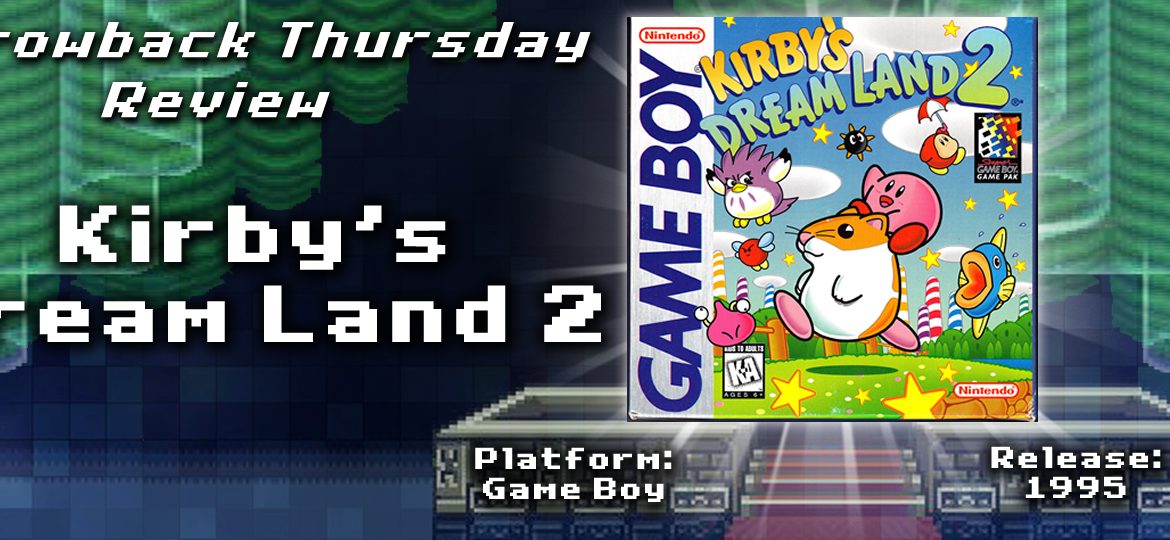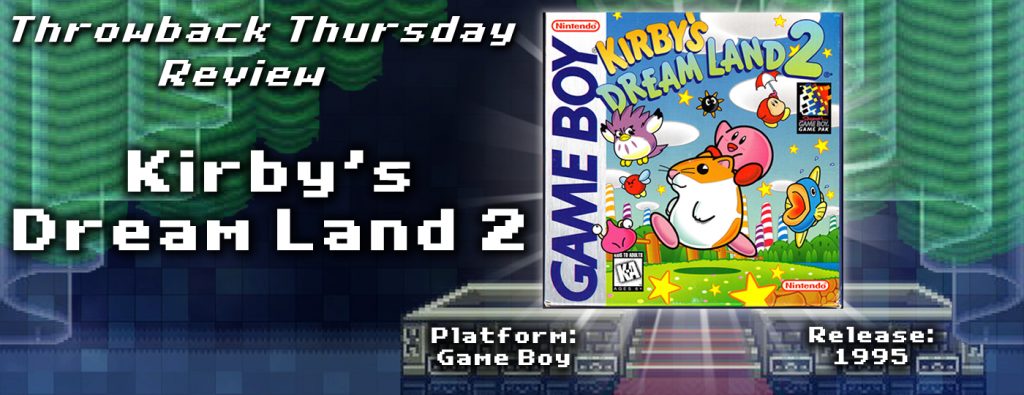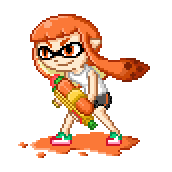This article was originally published on Gamnesia.com
It was later published on my personal website, thelostmd.com
Kirby’s Dream Land 2, the direct sequel to the Game Boy title that started the franchise, sees Kirby returning to Dream Land to find Rainbow Drops that have been stolen by the evil Dark Matter, who has possessed King Dedede, with an intent on conquering Dream Land. With the help of three new animal friends, Kirby has set out to find the Rainbow Drops to repair the Rainbow Bridges that connect the seven Rainbow Islands. The game builds upon its predecessor immensely, borrowing features from it’s console cousin, Kirby’s Adventure. With some key differences to make itself stand out amongst its predecessors, Kirby’s Dream Land 2 packs a charming little adventure into a small gray cartridge that many people are sure to enjoy.
Kirby’s Dream Land 2 is a platformer much like its predecessors Kirby’s Dream Land and Kirby’s Adventure, but has some fairly big differences from them both. Like the first game, Kirby can run, jump, suck in enemies, and float for a time, and like Kirby’s Adventureon the NES, Kirby now has his signature move: the ability to copy enemy powers. There are only a few different enemy types that can be used for their powers this time, but for a Game Boy title, it’s understandable.
A major tweak to the gameplay from Kirby’s Adventure is Kirby’s relative lack of mobility. Kirby moves slow with no ability to run or slide, making the game more difficult than it has to be. With the motion blur on the Game Boy, it’s understandable why Kirby doesn’t run and instead tacked that ability on to an animal, but it makes Kirby feel a little bit clunky to control. No clunkier than Kirby’s Dream Land, but a bit of an unnecessary step down from Kirby’s Adventure, which established what to expect from a Kirby title. It’s not a huge problem, but the game would have better control and would feel better to play if it had those two little abilities. But, again, the running ability was taken from Kirby in favor of applying it to an animal friend, this game’s major new addition to the franchise.
The biggest addition to Kirby’s Dream Land 2 are three animal friends who join Kirby on the adventure to save Dream Land. Each have their own unique advantage and can change how Kirby’s copied abilities work. Rick the hamster runs faster than Kirby and will not slip on icy surfaces, Coo the owl carries Kirby through harsh winds and allows Kirby to inhale enemies and objects while in the air (though to swallow them, Kirby has to land), and Kine the ocean sunfish, who gives Kirby much greater control in water, can swim against strong currents and allows Kirby to inhale enemies and objects underwater. Each of the animals add a layer of gameplay and exploration that adds to the replay value of the game.
Animal friends also have their own health bar that masks yours, so if you’re low on health, having an animal friend could act as a temporary shield. However, once they’re gone, you’ll have to find one to rescue once again. If you happen to go through a room that drops a specific animal friend and you’re already with that one, you will instead free Gooey, marking Gooey’s debut appearance in the Kirby franchise. Black Gooies refill a very small amount of health, but the rarer female Gooies grant an extra life.
Some secret items can only be obtained with the proper animal friend and the proper copied ability, which makes for some difficult platforming and occasional back-tracking, but they are well-placed in the level design and the game flows well with them.
The game is split up into seven worlds, the Rainbow Islands, each with their own set of levels and a boss at the end. Like in Kirby’s Adventure, one level must be completed to progress and there are secrets to find, but there are very few and they don’t affect the overworld itself. Gone are the museums and claw games in favor of saving space on the cartridge. The level design, however, is built a lot like Kirby’s Adventure, with the occasional branching paths and mini-bosses here and there. There are many more levels than Kirby’s first adventure had with its measly four stages, and some of them can be rather lengthy and difficult.
Within each world hidden on one of the stages is a Rainbow Drop, the pieces of the Rainbow Bridges that Kirby needs to collect. To collect a Rainbow Drop, Kirby will often have to use a copied ability from a specific enemy, use an animal friend and a specific ability, go through hidden passageways, and even go swap between different animal friends or powers in quick succession. Getting all of the Rainbow Drops can be fairly tricky, but they are required to unlock the final boss and view the complete ending. Bosses in previous levels will also provide a mini-game after they’ve been beaten to add a little extra replay value.
This next paragraph contains spoilers. One thing I have to mention about the gameplay is the final boss. The entire fight changes the gameplay by taking Kirby to space, where it is incredibly hard to move. That slow movement alone leads to a major spike in difficulty. I have found after playing the game on several different platforms that lag also plays a factor there, as the fight allows Kirby to move slightly faster on the Game Boy Color, though this lag was otherwise unnoticeable on a Game Boy Light or a Super Game Boy. I imagine most people reading this review are playing on the 3DS, so I’m sure that version will be the Game Boy / Pocket / Light experience. End of spoilers.
Graphically, the game takes after Kirby’s Adventure more than Dream Land. Sprites are well animated and highly detailed, and every character has a distinct personality. The first time you venture into any island, a short cutscene plays that provides a little cute comic relief as you go along. Poor Kine. When played on a Super Game Boy, these cutscenes are provided in full color.
Kirby’s Dream Land 2 is one of the games designed to work in conjunction with the Super Game Boy on the Super NES for added features. This provides a fitting color pallette, with colorful island designs on the overworld map and full-color cutscenes, including both full-color endings, the intro, and even a fancy border showing the three animal friends and Kirby together. The other feature that the Super Game Boy provides is an extra audio track, though it’s hardly used. The only additions I noticed are applause on the title screen, an extra track in the island world songs (not the levels themselves), and cute distinct cries from each of the three animal friends. It doesn’t add much to change the game as opposed to playing it on another device, but the color and audio combine to make the Super Game Boy the premier way to play the game.
As for the rest of the audio, many songs or themes are recycled from the previous two games, but none of them are bad. They each fit the worlds/stages well, and some can be rather catchy. With three unique songs for each of the animal friends as well, things are fairly well rounded. Nothing bad here, but I imagine only one or two songs will be memorable for most players.
The Verdict: A Little Short but Sweet
Kirby’s Dream Land 2 successfully builds upon its predecessors and provides a lovely, mid-length handheld adventure with few concessions made due to hardware limitations. It’s not as good as Kirby’s Adventure, but it certainly does its best with what it has. The game takes a huge page from Kirby’s Adventure with extra mini-games, distinct worlds, and the occasional secret to be found. The difficulty can spike near the end, but it’s far from impossible, and the final few fights are a satisfying test of your skills. There isn’t much in the way of replay value, but there are the hidden Rainbow Drops to find and the post-defeat boss challenge games to come back to if you’d like to have your file at 100%.Kirby’s Dream Land 2 makes a lovely addition to anyone’s Game Boy library. The game itself is relatively short, but it’s a fun ride and its charm will bring you back over and over for years to come.



